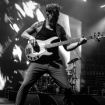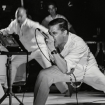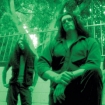From song titles like "Bullet in the Head" and "Killing in the Name," to an album cover emblazoned with the image of a Buddhist monk self-immolating in protest of the South Vietnamese government, to the very name of the band itself, it was clear that, upon its release on November 3, 1992, Rage Against the Machine's self-titled debut was designed for maximum impact. Eschewing both the feel-good, sex, drugs and rock & roll ethos that had characterized heavy music in the previous decade — as well as the often-solipsistic self-flagellation that infected much of the grunge and alternative music scenes at the time — Rage Against the Machine projected its, um, rage, outward, with frontman Zack de la Rocha unleashing incisive and insightful insurrectionist rhymes over his bandmates' elastic funk-metal onslaught.
But if Rage Against the Machine's words were, quite literally, revolutionary, they were equally matched by the accompanying music. The band's melding of hip-hop and funk with heavy rock riffing was unlike anything at the time (credit, or, perhaps, blame the record for helping to birth rap-metal), while Tom Morello's six-string acrobatics, which incorporated everything from fluid, almost fusion-y shredding and throttling single-note power riffing to inventive techniques that mimicked turntable scratches, air-raid sirens and all manner of samples, screeches and whistles, signaled the birth of a new kind of guitar hero for a new kind of decade. By the time the band appeared on the 1993 Lollapalooza festival in support of Rage Against the Machine, they were inspiring thousands of sweaty suburban kids to raise their voices in unison about the plight of imprisoned Native American activist Leonard Peltier as much as to get in the pit and rock out.
These days, it's safe to say that Rage Against the Machine stands among the most influential rock albums of the past quarter-century, and its songs sound just as urgent, incendiary and downright revolutionary as they did upon its release. In recognition of the album's 25th anniversary, here are 10 things you might not know about Rage Against the Machine.
1. Prior to the band's formation, Zack de la Rocha wrote a song titled "Rage Against the Machine"
The band name Rage Against the Machine has its origins in the title of an unreleased song De La Rocha wrote for his pre-Rage band Inside Out ("When you see the flag / will you bow down?" goes the first couplet). As for why he believed it would be a fitting moniker for his new band, De La Rocha told the LA Times in 1992, "I just felt it applied in the kind of message we were trying to put at the forefront of our music," he explained. "I wanted to think of something metaphorically that would describe my frustrations toward America, toward this capitalist system and how it has enslaved and exploited and created a very unjust situation for a lot of people."
2. Morello came up with the explosive riff at the center of "Killing in the Name" during, of all things, a guitar lesson
"Killing in the Name" is arguably one of the most incendiary rock songs of the past 25 years. But its origins are surprisingly studious. Morello came up with the slamming downtuned riff that fuels the song while working as a guitar teacher. "I was actually in the middle of playing bass in a guitar lesson," he recalled to Classic Rock magazine, "and was teaching a student about the drop-D tuning when it came to me. I said to him: 'Hold on one second,' and scribbled it down. Then we went into rehearsals that night and worked it out. It was part of the second wave of songs we ever wrote."
3. The band's label picked Rage Against the Machine's most profane track as the lead single
Morello has been vocal about the fact that Epic never put any undue pressure on the band, even when it came to lyrics. "There was never any resistance," he told LA Weekly. He added that it was actually Epic's idea to release the most profanity-laced song as the first single from Rage Against the Machine. "The record label actually suggested 'Killing in the Name,'" Morello said, "which contains the line, 'Fuck you I won't do what you tell me' 16 times and one 'motherfucker.' They knew that this was not a band that would craft pop hits.
It was also the label's suggestion to not edit lyrical content for video or for radio, which is why it exploded outside of here. 'Killing in the Name' and 'Bullet in the Head' were hit songs across Europe, South America and Japan where there were less stringent censorship laws."
4. While recording Rage Against the Machine, the band struggled to capture their live energy — so they turned the studio into a stage
For their first album, Rage intended to imbue the recordings with the same energy of their live show. But they found that doing so was easier said than done. "From the very first shows, the music always felt alive and powerful," Morello told Spin. But, he continued, "we went into the studio to record, we were having a very difficult time capturing that." The answer? Turn the studio into a concert venue. "The way we turned the corner was one night we invited a bunch of friends into the studio and basically just played the set," he explained. "So it was like a show, rather than, 'Now we're going to record the hi-hat.' We got about half of the basic tracks on the record that night. It sounded like Rage Against the Machine."
5. Rage could have been fronted by Maynard James Keenan
Maynard James Keenan makes an appearance on Rage Against the Machine's "Know Your Enemy" — that's him on the "I've got no patience now …" breakdown. But in a 2016 interview with Rolling Stone, the Tool frontman revealed that at one point, his involvement with Rage had the potential (or not) to be more than just a guest spot.
"We actually were in a rehearsal space," Keenan said, recalling that he had jammed with Morello and bassist Tim Commerford, and that drummer Brad Wilk may have been present as well. But, he added, "I think just the vibe of where they wanted to go ... I guess I had a little bit of that Green Jellö thing going on in me still, so I was looking for almost a Puscifer approach to music at that point. They were looking for a more serious approach, so I think that was pretty much immediate. If there was a consideration for that at all, it was very brief."
6. During the tour in support of Rage Against the Machine the band unleashed their naked rage, literally
Back in 1985, musicians like Frank Zappa and Twisted Sister's Dee Snider headed to Washington to speak out against the PMRC's bid to censor and sticker albums. But if the image of Snider testifying before a Senate subcommittee was shocking, it was perhaps trumped eight years later by Rage's onstage demonstration at the Philadelphia stop on the Lollapalooza tour on July 18, 1993 — where the band members, sans instruments, came onstage naked, their mouths taped shut and the letters "PMRC" emblazoned on their chests. The silent protest, which ate up the band's entire set time, elicited loud cheers from the crowd … at first. Recalled Commerford on the Dan LeBatard Show, "After 10 minutes of standing there naked, what started as cheers turned into bottle throwing, people were just bummed out. We were hauled off by the police … that was a special moment."
The band member also admitted that in addition to the protest itself, he had his own, um, member on his mind. "I referred to that moment for me as a half roll of nickels," Commerford said. "It was as if I came out of the ocean … it was incredible. I was trying to fluff things up to get the blood flow to happen. But it wasn't really happening!"












